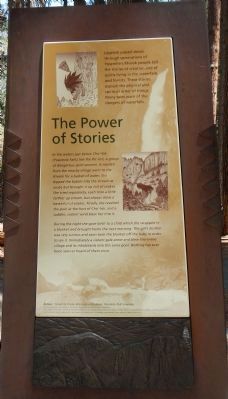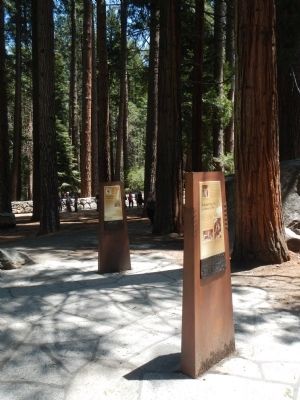Yosemite National Park in Mariposa County, California — The American West (Pacific Coastal)
The Ahwahneechee
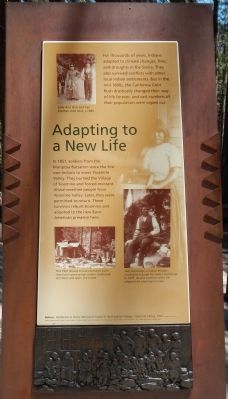
Photographed By Barry Swackhamer, May 15, 2013
1. Adapting to a New Life plaque
Captions: (top left) Sally Ann Dick and her brother John Dick, c. 1886; (bottom left) This 1901 Miwok house combines Euro-American construction with traditional dirt floor and open fire inside; (bottom right) Tom Hutchings, a native Miwok worked as a guide for James Hutchings in 1875. As was common then, he adopted his employer’s name; (bottom relief) Residents at Harry Johnson’s home in New Indian Village, Yosemite Valley, 1933.
Adapting to a New Life
For thousands of years, Indians adapted to climate changes, fires and droughts in the Sierra. They also survived conflicts with other local Indian settlements. But in the mid-1800s, the California Gold Rush drastically changed their way of life forever, and vast numbers of their population were wiped out.
In 1851, soldiers for the Mariposa Battalion were the first non-Indians to enter Yosemite Valley, They burned the Village of Koomine and forced resistant Ahwahneechee people from Yosemite Valley. Later, they were permitted to return. Those survivors rebuilt Koomine and adjusted to the new Euro-American presence here.
Preserving the Culture
In the early 1800s, about 3,000 Indians people lived here. By 1900, fewer than 200 survived. The others may have been victims of an epidemic. The U.S. Cavalry removed the Village of Koomien in 1906 and relocated its residents to another part of the Valley.
Ahwahneechee descendents still live here in Mariposa County and elsewhere. Many are teaching the younger generations, preserving Miwok and Ahwahneechee cultural traditions. The Yosemite Museum and the Indian Village of Ahwahnee (behind the museum) showcase the past and present-day culture.
The Power of Stories
Legends passed down through generations of Yosemite’s Miwok people tell the stories of creation and of spirits living in the waterfalls and forests. These stories explain the physical and spiritual order of things. Many tales warn of the dangers of waterfalls.
In the waters just below Cho’-lok (Yosemite Falls) live the Po’-loti, a group of dangerous spirit women. A maiden from the nearby village went to the stream for a basket of water. She dipped the basket into the stream as usual, but brought it up full of snakes. She tried repeatedly, each time a little father up stream, but always drew a basketful of snakes. Finally, she reached the pool at the foot of Cho’-lok, and a sudden violent wind blew her into it.
During the night she gave birth to a child which she wrapped in a blanket and brought home the next morning. The girl’s mother was very curious and soon took the blanket off the baby in order to see it. Immediately a violent gale arose and blew the entire village and its inhabitants into this same pool. Nothing has ever been seen or heard of them since.
Living With the Land
Ahwahneechee people regularly burned the Valley’s forests and meadows to keep them open for gathering and hunting. Ground fires in the oak woodlands helped acorns sprout and made collecting easier. Acorn
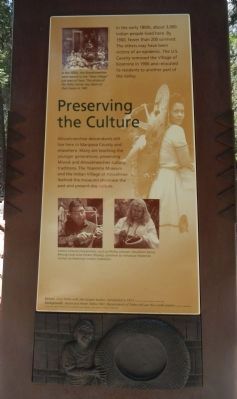
Photographed By Barry Swackhamer, May 15, 2013
2. Preserving the Culture plaque
Captions: (top left) In the 1930s, the Ahwahneechee were moved to the “New Village” just west of here. This photo of the Telles family was taken at their new home in 1941; (bottom left and right) Indian cultural interpreters, such as Phillip Johnson (Southern Sierra Miwok) and Julia Parker (Pomo), continue to introduce Yosemite visitors to American Indian traditions; (background) David and Helen Telles, 1941. Descendants of Telles still use this cradle basket; (bottom relief) Lucy Telles with here largest basket completed in 1913.
Yosemite Valley has been home to American Indians for approximately 8,000 years. Countless generations of Ahwahneechee lived in this area near Lower Yosemite Fall. You are standing on the site of their largest community, Koomine (Ku-mai-ni).
Erected by Yosemite Fund.
Topics. This historical marker is listed in this topic list: Native Americans. A significant historical year for this entry is 1851.
Location. 37° 44.818′ N, 119° 35.791′ W. Marker is in Yosemite National Park, California, in Mariposa County. Marker can be reached from Northside Drive, on the right when traveling west. Touch for map. Marker is in this post office area: Yosemite National Park CA 95389, United States of America. Touch for directions.
Other nearby markers. At least 8 other markers are within walking distance of this marker. James Hutchings (approx. 0.2 miles away); Early Tourism (approx. 0.2 miles away); John Muir... The Woodcutter (approx. ¼ mile away); The Old Yosemite Village (approx. 0.4 miles away); The Story of Half Dome (approx. half a mile away); Reawakening the Meadow (approx. half a mile away); Big Tree (approx. half a mile away); Yosemite National Park (approx. half a mile away). Touch for a list and map of all markers in Yosemite National Park.
More about this marker. This marker is located on the Lower Yosemite Fall Trail. The trail is a loop
with two entrances off of Northside Drive. This marker is near the western entrance.
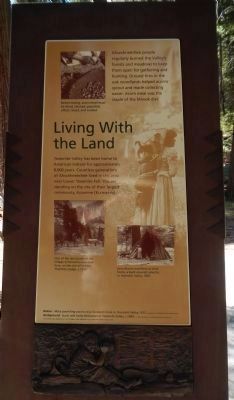
Photographed By Barry Swackhamer, May 15, 2013
4. Living with the Land plaque
Photograph captions: (top left) Before eating, acorn meat must be dried, cleaned, pounded, sifted, rinsed, and cooked; (bottom left) One of the homes in the Village of Koomine was near here, on the site of today’s Yosemite Lodge, c. 1890; (bottom right) Lena Brown and Mary at their home, a bark-covered umacha, in Yosemite Valley, 1887; (relief on the bottom) Mary pounding acorns near Sentinel Creek in Yosemite Valley, 1913; (background) Suzie and Sadie McGowan in Yosemite Valley, c. 1899.
Credits. This page was last revised on June 16, 2016. It was originally submitted on May 30, 2013, by Barry Swackhamer of Brentwood, California. This page has been viewed 1,035 times since then and 40 times this year. Photos: 1, 2, 3, 4, 5. submitted on May 30, 2013, by Barry Swackhamer of Brentwood, California. • Syd Whittle was the editor who published this page.
